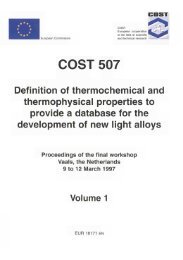Gear micropitting prediction using the Dang Van High-Cycle Fatigue ...
Gear micropitting prediction using the Dang Van High-Cycle Fatigue ...
Gear micropitting prediction using the Dang Van High-Cycle Fatigue ...
Create successful ePaper yourself
Turn your PDF publications into a flip-book with our unique Google optimized e-Paper software.
Abstract<br />
The <strong>micropitting</strong> gear tooth flank damage has attracted considerable attention in<br />
recent times. This is due to <strong>the</strong> fact that, as <strong>the</strong> performance of <strong>the</strong> lubricant oils<br />
and surface coatings of <strong>the</strong> gears allows for an increase in speeds and power transmission<br />
within <strong>the</strong> gearboxes, this type of damage becomes increasingly frequent,<br />
especially in surface hardened materials with current surface finishing.<br />
The <strong>micropitting</strong> damage consists in small craters (in <strong>the</strong> order of 10 µm in width<br />
and depth) appearing on <strong>the</strong> surface of a gear tooth. These craters are produced by<br />
<strong>the</strong> propagation of fatigue cracks that originate from <strong>the</strong> surface of <strong>the</strong> gear tooth,<br />
where a highly complex stress state is to be found because of <strong>the</strong> interaction of <strong>the</strong><br />
roughness features of <strong>the</strong> teeth. Because <strong>the</strong> propagation of one such fatigue crack<br />
is nearly instantaneous, when compared with <strong>the</strong> initiation time, and because of<br />
<strong>the</strong> highly localized nature of <strong>the</strong> phenomenon, allied to <strong>the</strong> complex multi-axial<br />
stress history of an initiation site, <strong>the</strong> classic fatigue criteria such as <strong>the</strong> Goodman<br />
or Soderberg line are inadequate for <strong>the</strong> present use.<br />
The aim of this work is to develop a model suitable for <strong>the</strong> analysis of tooth flank<br />
surface fatigue damage in spur gears, in particular <strong>micropitting</strong> contact fatigue<br />
initiation and mild wear. The prominent features of <strong>the</strong> model are a mixed film<br />
lubrication model and <strong>the</strong> application of <strong>the</strong> <strong>Dang</strong> <strong>Van</strong> high-cycle multi-axial fatigue<br />
criterion. By taking into account <strong>the</strong> roughness of <strong>the</strong> contacting gear teeth, <strong>the</strong><br />
non-Newtonian behaviour of <strong>the</strong> lubricating oil, <strong>the</strong> temperature variations within<br />
<strong>the</strong> contact and <strong>the</strong> elastic and fatigue properties of <strong>the</strong> gear material, it allows for<br />
a realistic, if approximate, modelling of <strong>the</strong> physical phenomena behind <strong>the</strong> onset<br />
of <strong>micropitting</strong>.<br />
The <strong>micropitting</strong> initiation model was used to simulate an actual <strong>micropitting</strong><br />
test. The comparison of <strong>the</strong> test with <strong>the</strong> simulation results proved sufficiently<br />
satisfactory to warrant fur<strong>the</strong>r work on <strong>the</strong> model.<br />
v
Resumo<br />
O dano por <strong>micropitting</strong> nos flancos das engrenagens tem atraído uma considerável<br />
atenção nos últimos tempos. Isso deve-se ao facto de que, à medida que as performances<br />
dos óleos lubrificantes e dos revestimentos superficiais das engrenagens<br />
vão permitindo aumentar as velocidades e potências transmitidas nas caixas de engrenagens,<br />
esse tipo de dano torna-se cada vez mais frequente, especialmente nas<br />
engrenagens endurecidas superficialmente e com acabamento superficial corrente.<br />
O dano de <strong>micropitting</strong> consiste no aparecimento de pequenas crateras (na ordem<br />
de 10 µm em largura e profundidade) na superfície dos flancos de engrenagem.<br />
Essas crateras são produzidas pela propagação de fissuras de fadiga originadas<br />
na superfície do dente, onde um estado de tensão altamente complexo impera,<br />
causado pela interacção entre as rugosidades dos dentes. A propagação dessas<br />
fendas é praticamente instantânea, quando comparada com o tempo de iniciação.<br />
Em conjunto com isso, a escala minúscula do fenómeno, aliada à complexidade do<br />
historial de tensões duma zona de iniciação tornam inviável o uso de critérios de<br />
fadiga clássicos, tais como as linhas de Goodman ou Soderberg.<br />
O objectivo deste trabalho é o desenvolvimento de um modelo adequado para a<br />
análise dos danos de fadiga nas superfícies dos flancos de engrenagens cilíndricas,<br />
com particular incidência sobre a iniciação de fadiga de contacto de <strong>micropitting</strong> e<br />
sobre o desgaste ligeiro. Os aspectos mais proeminentes do modelo são um modelo<br />
de lubrificação por filme misto e a aplicação do critério de fadiga multi-axial de<br />
elevado número de ciclos de <strong>Dang</strong> <strong>Van</strong>. Porque o modelo incorpora as rugosidades<br />
das engrenagens, a reologia não Newtoniana dos óleos de lubrificação, as variações<br />
térmicas no contacto e as propriedades elásticas e de fadiga do material de engrenagem,<br />
ele permite uma simulação realista, embora aproximada, dos fenómenos<br />
físicos que levam ao <strong>micropitting</strong>.<br />
O modelo de iniciação de <strong>micropitting</strong> foi usado para simular um teste de <strong>micropitting</strong>.<br />
A comparação do teste com a simulação revelou-se suficientemente<br />
satisfatória para dar continuação a trabalhos adicionais no âmbito deste modelo.<br />
vii

















